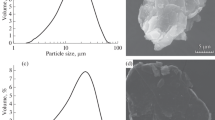Abstract
The possibility of influencing friction-induced processes and friction parameters through catalytic phenomena is discussed. A catalytic effect is shown using examples of material treatment and friction with the collection of electric current. The friction-induced catalytic effect is described based on nonequilibrium thermodynamics and the theory of self-organization. Addition of a catalyst into rubbing materials can help increase the wear rate of the materials under mechanical treatment or decrease the wear rate of wear-resistant materials by accelerating spontaneous or nonspontaneous physicochemical processes, respectively.
Similar content being viewed by others
References
D’yachenko, P.E., Effect of Surface Roughness on Its Wear, in Kachestvo poverkhnostei detalei mashin.” Kn. II (Quality of Machine Detail Surfaces. Book 2.), Moscow: Mashgiz, 1950.
D’yachenko, P.E., Vainshtein, V.E., and Chirkova, E.A., Dependence of Steel Wear from Surface Microgeometry, in Trenie i iznos v mashinakh (Friction and Wear in Machines), Moscow: AN SSSR, 1947.
Kosenko, P.A., Optimal Roughness of Rubbing Surfaces, in Kachestvo obrabotannykh poverkhnostei (Quality of Finished Surfaces), Moscow: Mashgiz, 1954.
Prokof’ev, I.I. and Protasov, V.V., Initial Wear and Machine Durability, Trudy Sar. Avtodor. Inst. (Proc. Sarat. Road Inst.), Saratov: Sar. Avtodor. Inst., 1954.
Tenenbaum, M.M., Iznosostoikost’ konstruktsionnykh materialov i detalei mashin (Wear Resistance of Construction Materials and Machine Details), Moscow: Mashinostroenie, 1966.
Protasov, B.V., Energeticheskie sootnosheniya v tribosopryazhenii i prognozirovanie ego dolgovechnosti (Energetic Relations in Triboconjugation and Forecast of Its Durability), Saratov: Saratov. Univ., 1979.
Gershman, I.S. and Bushe, N.A., Realization of Dissipative Self-Organization of Friction Surface in Tribosystems, Trenie Iznos, 1995. Vol. 16, no. 1, pp. 61–70.
Fedorov, S.V., Energeticheskie aspekty protsessa skhvatyvaniya tribosistem s razlichnymi podshipnikovymi splavami (Energetic Aspects of the Seizure Process of Tribosystems with Different Babbits), Kaliningrad: Kalining. God. Techn. Univ., 2005.
Gershman, I.S.. and Bushe, N.A., Elements of Thermodynamics and Self-Organization during Friction, in Self-Organization during Friction. Advanced Surface Engineered Materials and Systems Designed, London: Taylor and Francis, 2006.
Gershman, I.S. and Bushe, N.A., Compatibility of Tribosystems, in Self-Organization during Friction. Advanced Surface Engineered Materials and Systems Designed, London: Taylor and Francis, 2006.
Gershman, I.S., Formation of Secondary Structures and the Self-Organization Process of Tribosystems during Friction with the Collection of Electric Current, in Self-Organization during Friction. Advanced Surface Engineered Materials and Systems Designed, London: Taylor and Francis, 2006.
Fox-Rabinovich, G.S., Kovalev, A.I., Endrino, J.L., et al., Surface-Engineered Tool Materials for High Performance Machining in Self-Organization during Friction. Advanced Surface Engineered Materials and Systems Designed, London: Taylor and Francis, 2006.
Fox-Rabinovich, G.S., Gershman, I.S., Kovalev, A.I., and Yamamoto, K., Development of the Ternary and Higher-Ordered Protective or Wear-Resistant Materials and Coatings for High-Temperature Applications and Thermodynamics-Based Principles of Their Synergetic Alloying, in Self-Organization during Friction. Advanced Surface Engineered Materials and Systems Designed, London: Taylor and Francis, 2006.
Nikolis, G. and Prigozhin, I., Samoorganizatsiya v neravnovesnykh sistemakh (Self-Organization in Nonequilibrium Systems), Moscow: Mir, 1979.
Klimontovich, Yu.L., Vvedenie v fiziku otkrytykh system (Introduction in Physics of Open Systems), Moscow: Yanus-K, 2002.
Dukhovskoi, E.A., Ponomarev, A.N., Silin, A.A., and Tal’roze, V.L., Effect of Anomaly Low Friction upon Electronic Bombardment of Rubbing Surface by Molybdenum Disulphide, Pis’ma v Zh. Eksper. Teor. Fiz., 1974, vol. 20, no. 4, pp. 268–272.
Bogachev, I.M. and Mints, R.I., Povyshenie kavitatsionnoi stoikosti detalei mashin (Increasing of Cavitational Resistance of Machine Details), Moscow: Mashinostroenie, 1964.
Prigozhin, I. and Kondepudi, D., Sovremennaya termodinamika (Contemporary Thermodynamics), Moscow: Mir, 2002.
Ashkinazi, E.E., Ral’chenko, V.G., Frolov, V.D., et al., Friction of CVD Diamond on Intermetallide, J. Friction Wear, 2008, vol. 29, no. 4, pp. 277–281.
Heinecke, G., Tribochemistry, Berlin: Akademie-Verlag, 1984; Moscow: Mir, 1987.
Gershman, I.S., Trushevskii, S.M., and Shumitskii, A.V., Role of Carbon in Self-Organization of Process of Wear of Strong-Current Sliding Electrical Contacts, J. Friction Wear, 2000, vol. 21, no. 5, pp. 520–523.
Lu, Y., Xue, J.Z., and Shen, S.K., Activation of CH4, CO2 and Their Reactions over Co Catalyst Studied Using a Pulsed-Flow Micro-Reactor, Reaction Kinetics and Catalysis Letters, 1998, vol. 62, no. 2, pp. 365–371.
Eremin, A.V., Ziborov, V.S., Shumova, V.V., Voiki, D., and Roth, P., Formation of O (D-1) Atoms in ThermalDecomposition of CO2, Kinetics and Catalysis, 1997, vol. 38, no. 1, pp. 1–7.
Sakakini, B.H., Tabatabaei, J., Watson, M.J., and Waugh, K.C., Structural Changes of the Cu Surface of a Cu/ZnO/Al2O3 Catalyst, Resulting from Oxidation and Reduction, Probed by Co Infrared-Spectroscopy, J. Molec. Catalysis, A: Chem., 2000, vol. 162, nos. 1–2, pp. 297–306.
Ehrensberger, K., Palumbo, R., Larson, C., and Steinfeld, A., Production of Carbon from Carbon-Dioxide with Iron-Oxides and High-Temperature, Industr. Eng. Chem. Res., 1997, vol. 36, no. 3, pp. 645–648.
Hadden, R.A., Sakakini, B.H., Tabatabaei, J., and Waugh, K.C., Adsorption and Reaction Induced Morphological Changes of the Copper Surface of a Methanol Synthesis Catalyst, Catalysis Lett., 1997, vol. 44, nos. 3–4, pp. 145–151.
Wang, H.Y.. and Au, C.T., Carbon Dioxide Reforming of Methanol to Syngas over SiO2-Supported Rhodium Catalysts, Appl. Catal. A, 1997, vol. 155, no. 2, pp. 239252.
Tsuji, M., Yamamoto, T., Tamaura, Y., Kodama, T., and Kitauama, Y., Catalytic Acceleration for CO2 Decomposition into Carbon by Rh, Pt or Ce Impregnation onto Ni(II)-Bearing Ferrite, Appl. Catal. A, 1996, vol. 142, no. 1, pp. 31–45.
Author information
Authors and Affiliations
Corresponding author
Additional information
Original Russian Text © I.S. Gershman, E.I. Gershman, 2011, published in Trenie i Iznos, 2011, Vol. 32, No. 6, pp. 571–578.
About this article
Cite this article
Gershman, I.S., Gershman, E.I. Catalytic effect during friction. J. Frict. Wear 32, 431–436 (2011). https://doi.org/10.3103/S1068366611060067
Received:
Published:
Issue Date:
DOI: https://doi.org/10.3103/S1068366611060067




